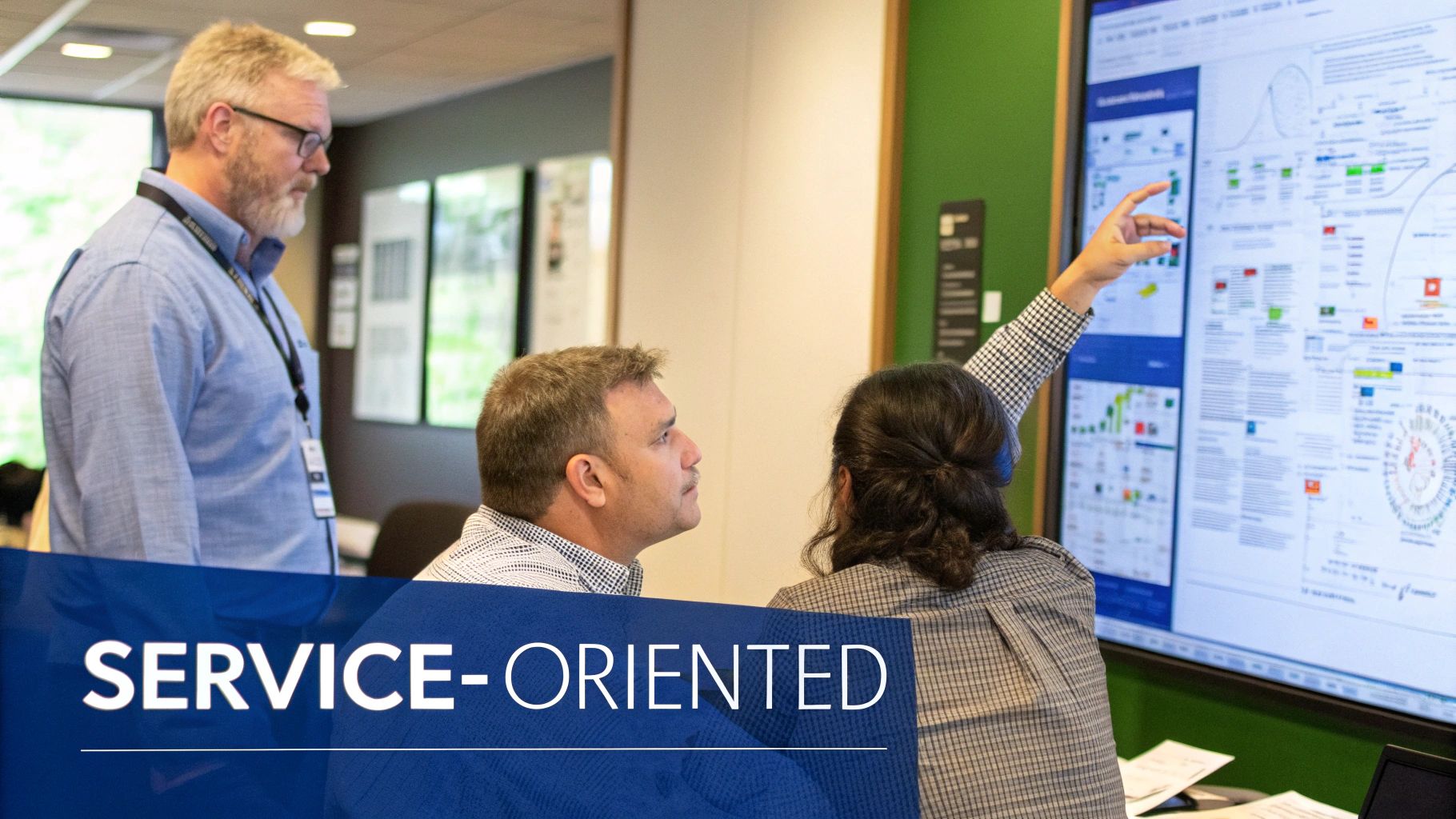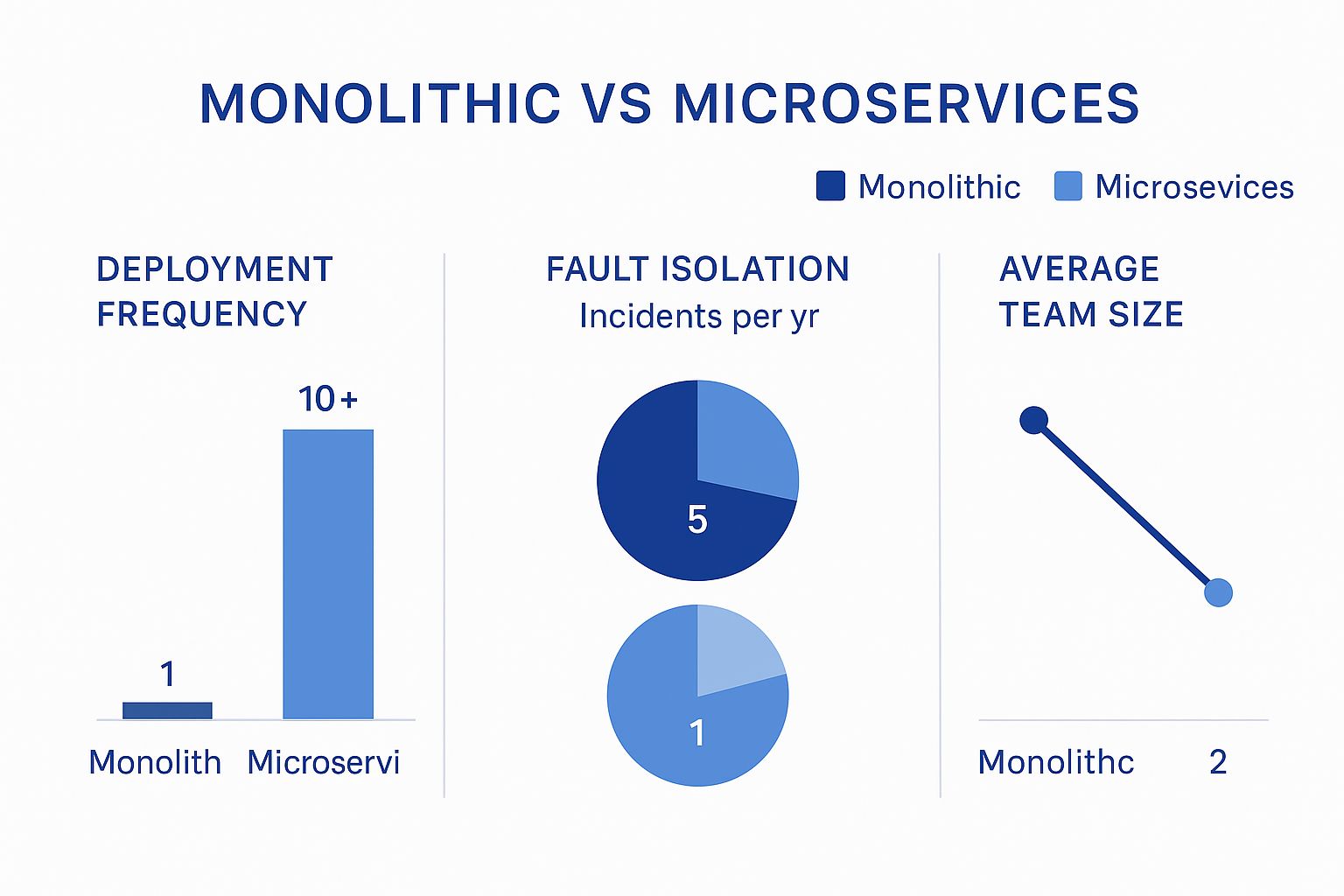Think of enterprise application architecture patterns as the proven blueprints for constructing large-scale, complex software. These aren't just technical diagrams; they are strategic frameworks that dictate how all the pieces of an application—from databases and user interfaces to backend services—are organized and how they talk to each other. The goal is always to build something that's scalable, easy to maintain, and actually helps the business succeed.
Understanding Enterprise Application Architecture Patterns

Let's use an analogy. Imagine building a city. If you just let everyone build wherever they want, you'd end up with a mess—traffic jams, inefficient utilities, and buildings that are impossible to expand or repair. A well-planned city, on the other hand, has clear zones, a solid road network, and infrastructure that can grow with the population.
This is exactly how it works with software. Without a solid architectural pattern, an enterprise application can quickly turn into a "digital traffic jam." It becomes slow, a nightmare to update, and brittle. That's why choosing the right pattern isn't just a tech decision; it's a critical business decision that directly impacts how your organization adapts, scales, and manages costs over the long haul.
Why Architecture Patterns Matter
Picking an architectural pattern is far more than a simple technical detail. It's the foundation that shapes the entire life of an application. The right structure gives development teams a clear roadmap, which helps enforce consistency and tame complexity from the start.
A software project’s success depends on the effectiveness of knowledge sharing between domain experts and software engineers. The job of analysts and engineers is to transform the expert’s mental model into software requirements and source code.
This kind of collaboration works so much better when it's guided by a well-understood architectural pattern. It creates a common language and a set of rules for how different parts of the system fit together. In fact, a staggering 71% of organizations report that not having a clear architectural strategy is a major cause of project delays and budget blowouts.
Enterprise applications cover a lot of ground. For example, ERP software solutions are a classic case where architectural planning is non-negotiable. These systems are packed with complex business logic and are expected to last for years, making that initial architectural choice incredibly important.
Key Goals of Enterprise Architecture
At the end of the day, every enterprise architecture pattern is trying to find the right balance between several competing priorities. Knowing these goals helps you understand why one pattern might be a better fit for a project than another.
- Scalability: Can the application handle more and more work? It needs to perform just as well for 100,000 users as it does for 100.
- Maintainability: How easy is it to fix bugs, boost performance, or adapt to new business requirements?
- Agility: How quickly can the team roll out new features or react to changes in the market?
- Resilience: How well does it bounce back from problems? If one small part fails, does it take the whole system down with it?
This guide will walk you through these core concepts, cutting through the jargon to give you a real-world understanding of how each pattern works. Getting this choice right is the first step to building a system that will deliver business value for years to come.
Digging into the Monolithic Architecture Pattern

Let's start our journey with the classic, the original: the monolithic pattern. Think of it like a massive, old-school department store. Everything you need—from clothing and electronics to customer service and the stockroom—is all under one roof, functioning as a single, giant operation.
That's a monolith in a nutshell. All the parts of the application are built, deployed, and run as one indivisible unit. The user interface, the core business rules, and the database connections are all tangled together in a single codebase. For a brand-new project, this straightforwardness can be a massive head start.
The Allure of Keeping It Simple
When you're just starting out, the monolithic approach is often the quickest path to getting your software out the door. Development feels direct and uncomplicated because the entire codebase is right there in one place. You don't have to wrestle with the complexities of how different services will talk to each other.
Getting it live is just as simple. You build the whole thing and push that one big package to your server. This unified approach makes the initial setup a breeze, which is a huge win for startups or small teams aiming for a fast launch.
A monolithic architecture puts all of its functionality into a single process and scales by replicating the monolith on multiple servers. The entire application is built as a single unit.
This really gets to the heart of it. The whole system works as one piece, which makes those early development cycles feel predictable and much easier to manage.
Where the Cracks Begin to Show
But, just like that department store, the monolithic model starts to feel cramped as the business expands. What happens when you want to upgrade just the cash registers? In a monolith, you can't just swap out one part. You have to shut down and renovate the entire store.
This "tight coupling" means a tiny change in one feature forces you to re-build, re-test, and re-deploy the entire application. As the software gets bigger, this process becomes painfully slow and incredibly risky, putting a major brake on how fast you can innovate.
Another big headache is technology. Want to try a new programming language or a modern framework? It's practically impossible without a complete, top-to-bottom rewrite. Teams get locked into the tech decisions made years ago, even when far better tools are available. This is how systems become outdated, and it’s why understanding effective legacy system migration strategies is so crucial for long-term planning.
Key Drawbacks of the Monolithic Pattern
Over the long life of an enterprise application, the limitations of a monolith really come into focus.
- Scalability Problems: If just one feature—say, your product search—is getting hammered with traffic, you have to scale the entire application. This is incredibly inefficient, forcing you to pay for extra resources for parts of the system that don't even need them.
- Fragile Reliability: A bug in a minor, non-essential module can crash the whole show. This single point of failure can create chaos for business operations.
- Sluggish Development: As the codebase swells, it takes longer to build and becomes a beast for new developers to understand. This friction slows down the release of new features to a crawl.
Even with these issues, the monolith isn't dead. It’s still a perfectly good choice for small projects, proofs-of-concept, or a minimum viable product (MVP) where speed is the number one priority. For those at the beginning stages, our custom enterprise software development guide provides more insight into that initial planning. But as a project grows up, the pressures of scale usually push teams to look for more flexible, modern alternatives.
The Evolution to Service-Oriented Architecture (SOA)

As enterprise systems grew, the old monolithic model started to show its cracks. It was just too big and rigid. The pressure was on to find a more modular and flexible way to build software, which set the stage for Service-Oriented Architecture (SOA). This was a massive shift away from the all-in-one approach.
Think of a bustling university campus. You have distinct departments like admissions, finance, and student records, each running its own show. They manage their own data and processes, but they can't operate in total isolation. For the university to work, they all need to talk to each other and share information.
That’s the core idea behind SOA. It breaks down a massive application into a collection of smaller, independent services that communicate over a network. Each service is built to handle a specific business job, like "process payment" or "check inventory." They're self-contained but can be easily discovered and used by other parts of the system.
The Central Nervous System: The Enterprise Service Bus
So, how do all these separate services coordinate? That's where the Enterprise Service Bus (ESB) often comes in. Sticking with our university analogy, the ESB is like the central administrative network that connects all the departments. It’s responsible for routing messages, translating data between different formats, and just making sure everyone can communicate reliably.
This central bus was a breakthrough because it allowed completely different systems, often built years apart with clashing technologies, to finally work together. A shiny new web app could pull data from a decades-old mainframe through the ESB, and neither system needed to know the messy technical details of the other. For large organisations trying to wrangle a hodgepodge of legacy applications, this was a game-changer.
The real power of SOA lies in reusability. A single "customer lookup" service, for instance, could be used by the sales, marketing, and support applications, which meant no more building the same thing over and over again.
This philosophy of building once and reusing everywhere drives huge gains in efficiency and consistency. It’s so effective that it has become a cornerstone for large-scale public sector bodies. The California Enterprise Architecture Framework (CEAF), for example, heavily relies on SOA to streamline processes across government departments. You can dig deeper into how California's framework uses these patterns to see it in action.
The Pros and Cons of an SOA Approach
Of course, no architectural pattern is perfect, and SOA has its own trade-offs. For organizations escaping the rigidity of monoliths, the benefits were immediately obvious.
- Increased Interoperability: Systems built on totally different platforms (like Java and .NET) could finally communicate.
- Service Reusability: Core business logic was wrapped into services that could be used across the entire organization, saving a ton of time and money.
- Improved Agility: Teams could update or even replace individual services without having to redeploy the whole application.
But SOA also introduced its own brand of headaches. The ESB, as powerful as it was, could quickly become a complex, single point of failure. All communication had to flow through this central hub, so if it went down, the entire system could grind to a halt. Managing and scaling the ESB became a highly specialized and often painful job.
This centralization also had a knack for slowing down development. Teams frequently had to coordinate their changes through a central group that owned the bus, creating bottlenecks. These frustrations ultimately helped push the industry toward even more decentralized patterns. If you're curious about where things went next, this overview of the most popular headless architecture technologies is a great read, as it builds on these foundational ideas of separating services.
Adopting Agility with Microservices Architecture
If you've been around enterprise software for a while, you've seen the pendulum swing from massive, all-in-one systems to more modular approaches. Microservices represent the far end of that swing, taking the idea of breaking things apart to its logical conclusion. It’s one of the most talked-about enterprise application architecture patterns for a good reason.
Think of it like moving from a single, giant factory that does everything under one roof to a network of small, specialized workshops. Each workshop is an expert at one thing—one forges the metal, another shapes the wood, a third handles the finishing. They are completely independent, and they coordinate their work through simple, standardized orders (which, in our world, are APIs). If the woodworking shop needs a new tool or has to shut down for a day, the metal forgery can keep right on working.
That’s the essence of microservices. Each service is built, deployed, and scaled on its own, focused on doing one business-related job and doing it well. This fine-grained separation is what gives it such remarkable flexibility and strength.
Unlocking True Development Independence
One of the biggest wins with microservices is the freedom it gives your development teams. Since every service is its own little application with its own codebase, teams can truly own their work from start to finish. This completely sidesteps the coordination headaches and merge-day nightmares that are so common in big, monolithic projects.
The team handling user authentication can happily work away without ever bumping into the team building the product recommendation engine. Better yet, they can use the right tool for their specific job. The authentication service might be built in Python for its fantastic security libraries, while the recommendation service could use a Java stack to chew through massive datasets. This kind of technological freedom doesn't just help teams move faster; it helps you hire and keep talented people who want to work with modern tools.
A much more important type of complexity is global complexity: the complexity of the overall structure of a program or system (i.e., the degree of association or interdependence among the major pieces of a program).
This is exactly the problem microservices aim to solve. By aggressively minimizing how much each component depends on the others, the system as a whole becomes much easier to grasp and change, one piece at a time.
Scalability and Resilience on a Granular Level
With a traditional monolith, if one feature gets slammed with traffic, you have to scale up the entire application. It's a blunt instrument. Microservices, on the other hand, let you be a surgeon. Is your shopping cart service getting hammered during a Black Friday sale? You can spin up more instances of just that service, leaving everything else untouched. This kind of targeted scaling is not only efficient but can also lead to some serious cost savings.
This independence also builds a tougher, more resilient system. Back in our workshop analogy, if one workshop has a problem, the others can usually keep going. It's the same here. If a non-critical service like "email notifications" goes down, it's not going to take your payment processing with it. This kind of fault isolation is a game-changer for any business where downtime is not an option.
The diagram below shows how this might look in a real-world e-commerce setup, with each service handling its own domain.
You can clearly see how concerns are separated. Services for Orders, Customers, and the Catalog all run independently but talk to each other to get the job done.
This move toward a more agile and durable model is picking up speed. In fact, recent statewide IT reports show that by 2024, somewhere between 30-40% of California state agencies and major companies have kicked off microservices adoption projects. Even more telling, this shift has reportedly sped up how often they can release application updates by an average of 35-40%. It’s hard to argue with numbers that show a direct line from this architecture to faster delivery. You can dive deeper into the state's strategy by reading about how California's enterprise architecture is evolving.
The Hidden Complexities of Distributed Systems
Of course, it’s not all sunshine and roses. Managing this fleet of specialized workshops brings its own set of headaches. While each individual service is simple, you've just traded one big, complex application for a complex distributed system. The operational overhead can be a real shock if you're not prepared for it.
You'll quickly run into some thorny problems:
- Service Discovery: In a dynamic environment where services are constantly starting and stopping, how does one service even find another to talk to?
- Data Consistency: When your data is scattered across a dozen different databases owned by different services, keeping it all in sync is a massive challenge. Transactions that have to touch multiple services are notoriously tricky.
- Monitoring and Debugging: Trying to follow a single user's request as it bounces between five or six different services can feel like detective work. You absolutely need specialized tools for distributed tracing and logging.
- Deployment Complexity: Sure, deploying one service is easy. But orchestrating the deployment of dozens of interdependent services without breaking anything requires serious automation and a mature DevOps practice.
Adopting microservices isn't just a technical choice—it's an organizational one. It requires a serious commitment to automation, sophisticated monitoring, and a company culture that lives and breathes DevOps. If you don't have that foundation in place, the operational complexity can easily swallow up all the benefits you were hoping for.
How to Choose the Right Architecture Pattern
Picking an enterprise application architecture isn't just a technical task you can check off a list. It's a major strategic decision that will echo through your business for years. The choice you make now directly impacts how well your company can grow, innovate, and adapt to whatever the market throws at it. Jumping on the latest trend without thinking it through is a surefire way to end up with a costly mess down the road.
Instead of asking, "What's everyone else using?", you need to start by looking inward. The right questions, grounded in your company's reality, will lead you to the right architecture. This isn't about following tech fads; it's about making a sound business decision.
Key Questions for Your Team
Get your tech leads and business stakeholders in a room and hash out the answers to these questions before you write a single line of code. Being brutally honest here will save you a world of pain later.
- Business and Scalability Needs: Where do you see this application in five years? If you're expecting explosive growth in certain parts of the app or need to roll out new features constantly, a more flexible pattern like microservices could be a lifesaver.
- Team Skills and Structure: What can your development team actually do? A monolith is often much easier for a smaller, tight-knit team to handle. Microservices, on the other hand, require serious DevOps muscle and experience with the complexities of distributed systems.
- Speed to Market: Is your main priority getting an MVP out the door yesterday? The straightforward nature of a monolith usually means a faster initial build, which can be critical for getting early user feedback.
- Operational Overhead: Are you truly prepared for the complexity of a distributed system? Juggling dozens of services demands a hefty investment in automation, monitoring, and specialized tools. It’s a significant operational commitment.
Working through these points helps you match your specific situation to the pros and cons of each pattern. This self-assessment is a cornerstone of any smart enterprise application modernization strategy, ensuring your tech choices are actually driving business goals.
Making the Decision Clearer
To get into the nitty-gritty technical details, this comparison of Monolith vs Microservices Architecture is a great resource that lays out the trade-offs clearly.
The image below also does a great job of showing the real-world operational differences at a glance.

What this data highlights is that while microservices offer more frequent deployments and better fault isolation, they depend on smaller, specialized teams. That’s not just a technical change; it’s a fundamental shift in how your organization is structured.
Comparing Enterprise Architecture Patterns
To bring it all together, this table offers a side-by-side look at how each major pattern stacks up against common enterprise needs.
| Characteristic | Monolithic | Service-Oriented Architecture (SOA) | Microservices |
|---|---|---|---|
| Initial Development Speed | Fast. Unified codebase simplifies initial setup. | Moderate. Requires upfront design of services and middleware. | Slow to Moderate. Requires setting up CI/CD, service discovery, etc. |
| Scalability | Difficult. Must scale the entire application at once. | Moderate. Services can be scaled, but often share resources. | High. Individual services can be scaled independently. |
| Team Structure | Best for single, co-located teams. | Works with multiple teams, coordinated through a central group. | Ideal for small, autonomous, cross-functional teams. |
| Technology Flexibility | Low. A single technology stack for the entire application. | Moderate. Different services can use different technologies. | High. Each microservice can use the best tech for its specific job. |
| Operational Complexity | Low. Simple to deploy and monitor one application. | High. Requires managing middleware, service contracts, and governance. | Very High. Requires sophisticated automation, monitoring, and DevOps. |
| Fault Isolation | Poor. An error in one module can bring down the whole app. | Good. Failure in one service is less likely to affect others. | Excellent. Failures are contained within a single microservice. |
This comparison makes it clear that there's no single "best" choice—only the best fit for your specific context.
The goal isn't to find the "best" architecture; it's to find the best-fit architecture for your specific problem domain, organizational culture, and business objectives.
In the end, it all comes down to trade-offs. A monolith gives you simplicity upfront but can cost you flexibility later. Microservices offer amazing agility and scale, but they demand a high level of operational maturity from day one. By asking the right questions from the start, you can make a strategic choice that sets you up for success, not just for today, but for the long haul.
The Future of Enterprise Application Architecture
The world of enterprise application architecture isn't static. The blueprints we rely on are constantly evolving as business needs get more demanding and new technologies create new possibilities. Looking ahead, a handful of powerful trends are already shaping the next wave of enterprise software, promising systems that are smarter, faster, and more efficient.
Keeping an eye on these future directions is more than just a thought exercise. It's about making smart decisions today to avoid building tomorrow's legacy headaches. The real goal is to design systems that are ready for what's just around the corner.
Embracing Serverless and Event-Driven Models
One of the biggest changes we're seeing is the push towards serverless architectures. This isn't about getting rid of servers entirely, of course, but about abstracting them away. With a serverless approach, developers can build and run applications without ever having to provision or manage the underlying infrastructure. All that heavy lifting—scaling, patching, and maintenance—is handled automatically by the cloud provider, freeing up teams to focus on writing code that actually moves the business forward.
Hand-in-hand with serverless comes the growing adoption of event-driven architecture (EDA). Think of it like a chain reaction. A customer places an order, which is an "event." This event automatically triggers another process, like an inventory update service. That update, in turn, might trigger a notification to the shipping department. Each component acts independently, reacting to events as they happen, creating a highly responsive and loosely-coupled system that excels at handling unpredictable spikes in traffic and real-time data.
By focusing on events as the primary means of communication between components, organizations can build systems that are more resilient, scalable, and adaptable to changing business requirements.
This isn't a niche concept anymore. It's becoming the standard for any business where real-time updates and instant analytics are expected, not just a nice-to-have.
The Influence of AI and Machine Learning
The rapid rise of artificial intelligence and machine learning is also rewriting the rules for system design. Applications are becoming more intelligent, and that intelligence requires architectures capable of handling the enormous, data-heavy workloads needed for training models and serving up predictions in real time.
This has spurred the development of patterns built specifically for the age of AI:
- Data-centric architectures that are designed around the efficient flow and processing of massive datasets.
- MLOps (Machine Learning Operations) frameworks that bake model development, training, and deployment into a smooth, continuous pipeline, much like DevOps does for software.
- Composable architectures that let teams easily plug together different AI components and services, almost like building with LEGO bricks.
Building for an AI-powered future is as much about culture as it is about technology. It means creating an environment where teams are encouraged to experiment and learn continuously. The companies that will lead the pack are those that empower their teams to explore these new enterprise application architecture patterns, test out emerging tools, and stay a step ahead. It’s about building for the intelligent, data-driven challenges that are not just coming, but are already here.
Frequently Asked Questions
Diving into enterprise application architecture can feel like learning a new language. It’s natural to have questions. Here are a few common ones we hear from teams trying to map out their architectural future, along with some straightforward answers.
Can We Actually Mix Different Architecture Patterns?
You absolutely can. In fact, for most large, complex organisations, a hybrid approach isn't just possible—it's often the smartest way to go. It’s pretty rare for one single pattern to be the perfect solution for every single part of a massive enterprise system.
Think of it this way: a company might keep its core back-office system, the one that handles billing and rarely changes, as a solid monolith. But for its new customer-facing mobile app, where features need to be added and updated constantly, they might opt for microservices. This lets them get the best of both worlds: stability where it’s needed and agility where it counts.
What's The Biggest Pitfall When Moving to Microservices?
The number one mistake we see is underestimating the sheer operational complexity that comes with the territory. Teams often get swept up in the promise of development speed and scalability but find themselves completely unprepared for the reality of managing a distributed system.
The overhead of handling service discovery, ensuring data stays consistent across dozens of services, and keeping an eye on everything with distributed monitoring can easily swamp a team that isn't ready for it. When that happens, all the benefits you were hoping for can quickly evaporate.
Before you even think about writing the first line of code for a microservice, you need to have a rock-solid foundation in place. This includes:
- Automation: Non-negotiable. You need mature CI/CD pipelines from day one.
- Monitoring: Basic logging won't cut it. You need advanced tools for distributed tracing to see how requests flow through your system.
- A Strong DevOps Culture: Your teams must be empowered and equipped to own their services all the way from development to production.
How Much Does the Cloud Really Change Our Architectural Choices?
It changes everything. Cloud platforms have completely reshaped the conversation around enterprise application architecture. Services from providers like AWS, Azure, and Google Cloud are built from the ground up to support systems that are distributed, scalable, and resilient. This makes patterns like microservices and serverless a much more natural choice than they used to be.
Cloud providers give you managed databases, message queues, and service discovery tools right out of the box. This drastically lowers the barrier to entry for adopting these more complex architectures. It’s the reason why "cloud-native" and "microservices" are so often mentioned in the same breath—the cloud provides the perfect ecosystem for these patterns to flourish, making them the go-to for many new applications today.
At Cleffex Digital ltd, we specialize in designing and building robust enterprise architectures that are perfectly aligned with your business goals. Contact us to build a future-proof foundation for your applications.
Article created using Outrank








